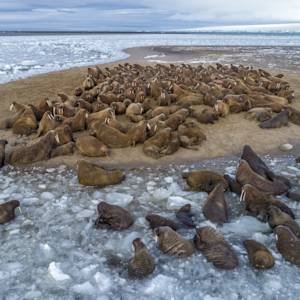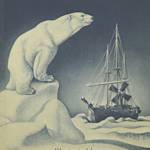Arctic tundra
2023 CE • Arctic
"Arctic tundra is located in the northern hemisphere, encircling the north pole and extending south to the coniferous forests of the taiga. The arctic is known for its cold, desert-like conditions . . . A layer of permanently frozen subsoil called permafrost exists, consisting mostly of gravel and finer material. When water saturates the upper surface, bogs and ponds may form, providing moisture for plants. There are no deep root systems in the vegetation of the arctic tundra, however, there are still a wide variety of plants that are able to resist the cold climate. There are about 1,700 kinds of plants in the arctic and subarctic." The arctic tundra is also home to a variety of animal species including caribou, lemmings, artic foxes, wolves, and polars bears. Migratory birds can be found amongst the tundra, such as "ravens, snow buntings, falcons, loons, sandpipers, terns, snow birds, and various species of gulls." The Arctic tundra is facing a number of threats due to climate change. The warming of the region is causing the permafrost to thaw, leading to erosion, changes in vegetation, and the release of large amounts of greenhouse gases. As temperatures continue to rise in the Arctic tundra, invasive and non-native species are migrating to the region, upsetting the delicate ecological balance. These species outcompete native plants, altering the structure of the tundra and affecting the availability of resources for native wildlife.
Quote: "The tundra biome," University of California Museum of Paleontology, last updated March 2007. Christina Nunez, "Tundra threats, explained," National Geographic, June 19, 2019.
Image: GRID-Arendal via Flickr, Peter Prokosch, Attribution-NonCommercial-ShareAlike 2.0 Generic (CC BY-NC-SA 2.0)


Learn about Maya Lin’s fifth and final memorial: a multi-platform science based artwork that presents an ecological history of our world - past, present, and future.

Discover ecological histories and stories of former abundance, loss, and recovery on the map of memory.

Learn how we can reduce our emissions and protect and restore species and habitats – around the world.

See how art can help us rethink the problems we face, and give us hope that each one of us can make a difference.

Help make a global memorial something personal and close to home. Share your stories of the natural world.


